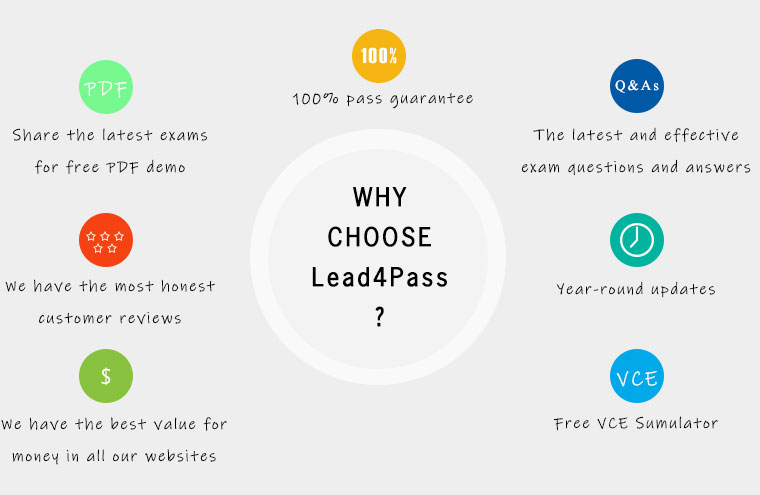Best IT Exam Dumps Practice Files Free Try At Leads4pass
Best Microsoft, Cisco, CompTIA And Other IT Exam Dumps Questions And Answers Download Free Try
Latest Updates Microsoft other Certification AI-100 exam dumps, online exam Practice | 100% Free
We share the latest exam dumps throughout the year to help you improve your skills and experience! The latest Microsoft other Certification AI-100 exam dumps, online exam Practice test to test your strength, Microsoft AI-100 “Designing and Implementing an Azure AI Solution (beta)” in https://www.leads4pass.com/ai-100.html Update the exam content throughout the year to ensure that all exam content is authentic and valid. AI-100 PDF Online download for easy learning.
[PDF] Free Microsoft other Certification AI-100 pdf dumps download from Google Drive: https://drive.google.com/open?id=1JavHvNcaFhxxGGLavTcFI0hG3MwGM3b5
[PDF] Free Full Microsoft pdf dumps download from Google Drive: https://drive.google.com/open?id=1AwBFPqkvdpJBfxdZ3nGjtkHQZYdBsRVz
Exam AI-100: Designing and Implementing an Azure AI Solution (beta): https://www.microsoft.com/en-us/learning/exam-ai-100.aspx
Candidates for this exam analyze requirements for AI cloud-based and hybrid AI solutions, recommends appropriate tools and technologies,
and implements solutions that meet scalability and performance requirements.
Candidates are aware of the various components that make up the Microsoft Azure AI portfolio, related open source frameworks and technologies, and available data storage options. Candidates use their understanding of cost models, capacity, and best practices to architect and implement AI solutions.
Analyze solution requirements (20-25%)
- Identify storage solutions
- Recommend tools, technologies, and processes to meet process flow requirements
- Map security requirements to tools, technologies, and processes
- Select software and services required to support the solution
Design solutions (30-35%)
- Design an AI solution that includes one or more pipelines
- Design the compute infrastructure to support a solution
- Design Intelligent Edge solutions
- Design data governance
- Design solutions that adhere to cost constraints
Integrate AI models into solutions (25-30%)
- Orchestrate an AI workflow
- Integrate AI services with solution components
- Integrate Intelligent Edge with solutions
Deploy and manage solutions (20-25%)
- Provision required cloud, on-premises, and hybrid environments
- Validate solutions to ensure compliance with data privacy and security requirements
- Monitor and evaluate the AI environment
Free test Microsoft other Certification AI-100 Exam questions and Answers
QUESTION 1
You develop a custom application that uses a token to connect to Azure Cognitive Services resources.
A new security policy requires that all access keys are changed every 30 days.
You need to recommend a solution to implement the security policy.
Which three actions should you recommend be performed every 30 days? To answer, move the appropriate actions
from the list of actions to the answer area and arrange them in the correct order.
Select and Place:
Correct Answer:
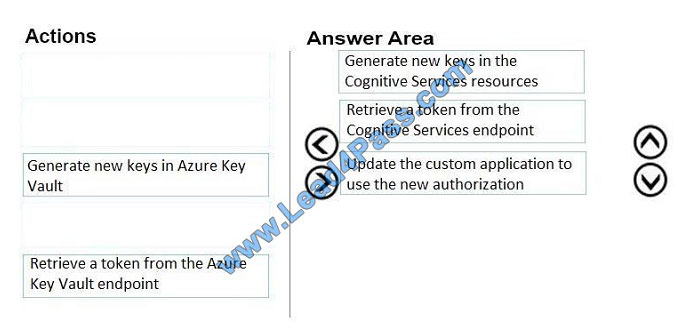
Step 1: Generate new keys in the Cognitive Service resources
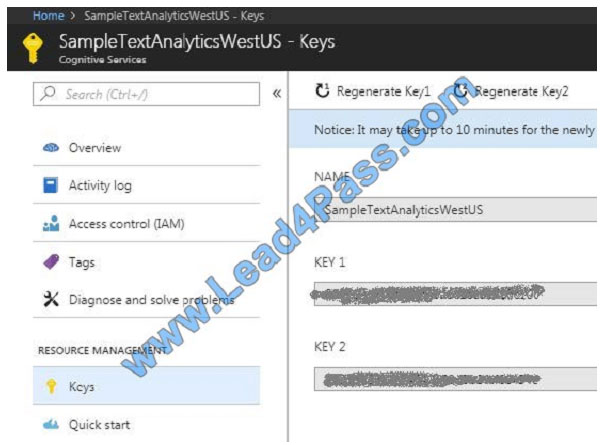
Step 2: Retrieve a token from the Cognitive Services endpoint Step 3: Update the custom application to use the new
authorization Each request to an Azure Cognitive Service must include an authentication header. This header passes
along a subscription key or access token, which is used to validate your subscription for a service or group of services.
References: https://docs.microsoft.com/en-us/azure/cognitive-services/authentication
QUESTION 2
Note: This question is part of a series of questions that present the same scenario. Each question in the series contains
a unique solution that might meet the stated goals. Some question sets might have more than one correct solution,
while
others might not have a correct solution.
After you answer a question, you will NOT be able to return to it. As a result, these questions will not appear in the
review screen.
You have Azure IoT Edge devices that generate streaming data.
On the devices, you need to detect anomalies in the data by using Azure Machine Learning models. Once an anomaly
is detected, the devices must add information about the anomaly to the Azure IoT Hub stream.
Solution: You deploy Azure Functions as an IoT Edge module.
Does this meet the goal?
A. Yes
B. No
Correct Answer: B
Instead use Azure Stream Analytics and REST API.
Note. Available in both the cloud and Azure IoT Edge, Azure Stream Analytics offers built-in machine learning based
anomaly detection capabilities that can be used to monitor the two most commonly occurring anomalies: temporary and
persistent.
Stream Analytics supports user-defined functions, via REST API, that call out to Azure Machine Learning endpoints.
References:
https://docs.microsoft.com/en-us/azure/stream-analytics/stream-analytics-machine-learning-anomaly-detection
QUESTION 3
You have several AI applications that use an Azure Kubernetes Service (AKS) cluster. The cluster supports a maximum
of 32 nodes.
You discover that occasionally and unpredictably, the application requires more than 32 nodes.
You need to recommend a solution to handle the unpredictable application load.
Which scaling method should you recommend?
A. horizontal pod autoscaler
B. cluster autoscaler
C. manual scaling
D. Azure Container Instances
Correct Answer: B
To keep up with application demands in Azure Kubernetes Service (AKS), you may need to adjust the number of nodes
that run your workloads. The cluster autoscaler component can watch for pods in your cluster that can\\’t be scheduled
because of resource constraints. When issues are detected, the number of nodes is increased to meet the application
demand. Nodes are also regularly checked for a lack of running pods, with the number of nodes then decreased as
needed. This ability to automatically scale up or down the number of nodes in your AKS cluster lets you run an efficient,
cost-effective cluster.
References: https://docs.microsoft.com/en-us/azure/aks/cluster-autoscaler
QUESTION 4
You are designing an AI workflow that will aggregate data stored in Azure as JSON documents.
You expect to store more than 2 TB of new data daily.
You need to choose the data storage service for the data. The solution must minimize costs.
Which data storage service should you choose?
A. Azure Manage Disks
B. Azure Blob Storage
C. Azure File Storage
D. Azure Data Lake Storage
Correct Answer: B
Generally, Data Lake will be a bit more expensive although they are in close range of each other. Blob storage has
more options for pricing depending upon things like how frequently you need to access your data (cold vs hot storage).
Data Lake is priced on volume, so it will go up as you reach certain tiers of volume.
References: http://blog.pragmaticworks.com/azure-data-lake-vs-azure-blob-storage-in-data-warehousing
QUESTION 5
You are developing a Computer Vision application.
You plan to use a workflow that will load data from an on-premises database to Azure Blob storage, and then connect to
an Azure Machine Learning service.
What should you use to orchestrate the workflow?
A. Azure Kubernetes Service (AKS)
B. Azure Pipelines
C. Azure Data Factory
D. Azure Container Instances
Correct Answer: C
With Azure Data Factory you can use workflows to orchestrate data integration and data transformation processes at
scale. Build data integration, and easily transform and integrate big data processing and machine learning with the
visual interface.
References: https://azure.microsoft.com/en-us/services/data-factory/
QUESTION 6
You are designing an AI solution that will analyze millions of pictures.
You need to recommend a solution for storing the pictures. The solution must minimize costs.
Which storage solution should you recommend?
A. an Azure Data Lake store
B. Azure File Storage
C. Azure Blob storage
D. Azure Table storage
Correct Answer: C
Data Lake will be a bit more expensive although they are in close range of each other. Blob storage has more options
for pricing depending upon things like how frequently you need to access your data (cold vs hot storage).
References: http://blog.pragmaticworks.com/azure-data-lake-vs-azure-blob-storage-in-data-warehousing
QUESTION 7
You are configuring data persistence for a Microsoft Bot Framework application. The application requires a structured
NoSQL cloud data store.
You need to identify a storage solution for the application. The solution must minimize costs.
What should you identify?
A. Azure Blob storage
B. Azure Cosmos DB
C. Azure HDInsight
D. Azure Table storage
Correct Answer: D
Table Storage is a NoSQL key-value store for rapid development using massive semi-structured datasets
You can develop applications on Cosmos DB using popular NoSQL APIs.
Both services have a different scenario and pricing model.
While Azure Storage Tables is aimed at high capacity on a single region (optional secondary read only region but no
failover), indexing by PK/RK and storage-optimized pricing; Azure Cosmos DB Tables aims for high throughput (single-
digit
millisecond latency), global distribution (multiple failover), SLA-backed predictive performance with automatic indexing
of each attribute/property and a pricing model focused on throughput.
References:
https://db-engines.com/en/system/Microsoft+Azure+Cosmos+DB%3BMicrosoft+Azure+Table+Storage
QUESTION 8
Note: This question is part of a series of questions that present the same scenario. Each question in the series contains
a unique solution that might meet the stated goals. Some question sets might have more than one correct solution,
while
others might not have a correct solution.
After you answer a question, you will NOT be able to return to it. As a result, these questions will not appear in the
review screen.
You have Azure IoT Edge devices that generate streaming data.
On the devices, you need to detect anomalies in the data by using Azure Machine Learning models. Once an anomaly
is detected, the devices must add information about the anomaly to the Azure IoT Hub stream.
Solution: You expose a Machine Learning model as an Azure web service.
Does this meet the goal?
A. Yes
B. No
Correct Answer: B
Instead use Azure Stream Analytics and REST API.
Note. Available in both the cloud and Azure IoT Edge, Azure Stream Analytics offers built-in machine learning based
anomaly detection capabilities that can be used to monitor the two most commonly occurring anomalies: temporary and
persistent.
Stream Analytics supports user-defined functions, via REST API, that call out to Azure Machine Learning endpoints.
References:
https://docs.microsoft.com/en-us/azure/stream-analytics/stream-analytics-machine-learning-anomaly-detection
QUESTION 9
You are designing an application to parse images of business forms and upload the data to a database. The upload
process will occur once a week.
You need to recommend which services to use for the application. The solution must minimize infrastructure costs.
Which services should you recommend? To answer, select the appropriate options in the answer area.
NOTE: Each correct selection is worth one point.
Hot Area: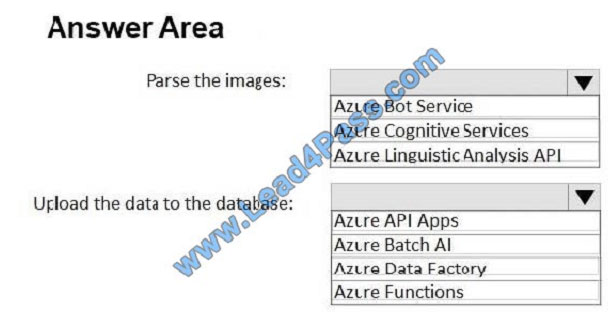
Correct Answer:
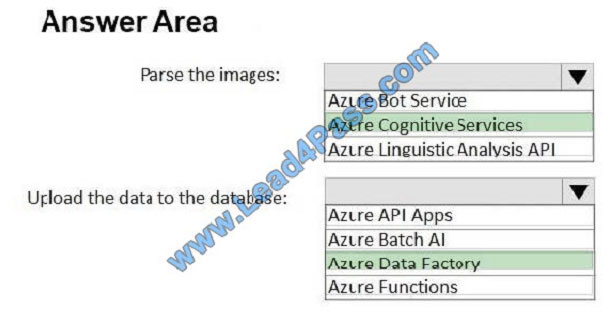
Box 1: Azure Cognitive Services
Azure Cognitive Services include image-processing algorithms to smartly identify, caption, index, and moderate your
pictures and videos.
Not: Azure Linguistic Analytics API, which provides advanced natural language processing over raw text.
Box 2: Azure Data Factory
The Azure Data Factory (ADF) is a service designed to allow developers to integrate disparate data sources. It is a
platform somewhat like SSIS in the cloud to manage the data you have both on-prem and in the cloud.
It provides access to on-premises data in SQL Server and cloud data in Azure Storage (Blob and Tables) and Azure
SQL Database.
References:
https://azure.microsoft.com/en-us/services/cognitive-services/
https://www.jamesserra.com/archive/2014/11/what-is-azure-data-factory/
QUESTION 10
Your company plans to deploy an AI solution that processes IoT data in real-time.
You need to recommend a solution for the planned deployment that meets the following requirements:
Sustain up to 50 Mbps of events without throttling.
Retain data for 60 days. What should you recommend?
A.
Apache Kafka
B.
Microsoft Azure IoT Hub
C.
Microsoft Azure Data Factory
D.
Microsoft Azure Machine Learning
Correct Answer: A
Apache Kafka is an open-source distributed streaming platform that can be used to build real-time streaming data
pipelines and applications.
References: https://docs.microsoft.com/en-us/azure/hdinsight/kafka/apache-kafka-introduction
QUESTION 11
You have Azure IoT Edge devices that generate measurement data from temperature sensors. The data changes very
slowly.
You need to analyze the data in a temporal two-minute window. If the temperature rises five degrees above a limit, an
alert must be raised. The solution must minimize the development of custom code.
What should you use?
A. A Machine Learning model as a web service
B. an Azure Machine Learning model as an IoT Edge module
C. Azure Stream Analytics as an IoT Edge module
D. Azure Functions as an IoT Edge module
Correct Answer: C
References: https://docs.microsoft.com/en-us/azure/iot-edge/tutorial-deploy-stream-analytics
QUESTION 12
You create an image classification model in Azure Machine Learning Studio.
You need to deploy the model as a containerized web service.
Which four actions should you perform in sequence? To answer, move the appropriate actions from the list of actions to
the answer area and arrange them in the correct order.
Select and Place:
Correct Answer:
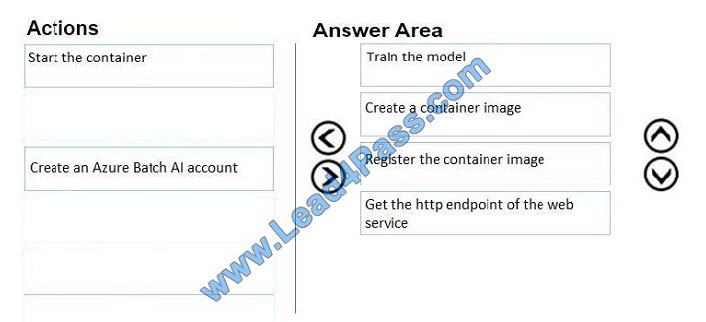
The following diagram illustrates the complete deployment workflow:
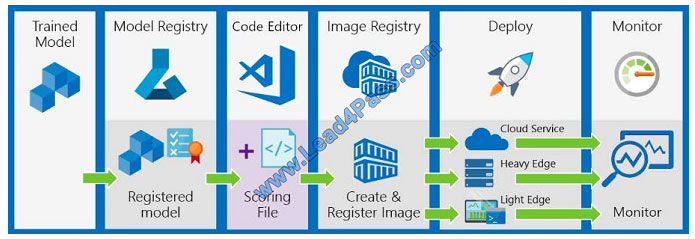
The deployment workflow includes the following steps:
1. Register the model in a registry hosted in your Azure Machine Learning Service workspace
2. Register an image that pairs a model with a scoring script and dependencies in a portable container
3. Deploy the image as a web service in the cloud or to edge devices
4. Monitor and collect data
5. Update a deployment to use a new image.
References: https://docs.microsoft.com/bs-latn-ba/azure/machine-learning/service/concept-model-management-and-
deployment#step-3-deploy-image
QUESTION 13
You are developing an application that will perform clickstream analysis. The application will ingest and analyze millions
of messages in the real time.
You need to ensure that communication between the application and devices is bidirectional.
What should you use for data ingestion and stream processing? To answer, select the appropriate options in the answer
area.
NOTE: Each correct selection is worth one point.
Hot Area:
Correct Answer:
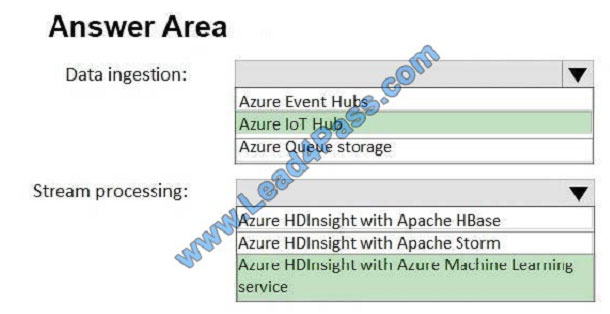
Box 1: Azure IoT Hub
Azure IoT Hub is the cloud gateway that connects IoT devices to gather data and drive business insights and
automation. In addition, IoT Hub includes features that enrich the relationship between your devices and your backend
systems.
Bidirectional communication capabilities mean that while you receive data from devices you can also send commands
and policies back to devices.
Note on why not Azure Event Hubs: An Azure IoT Hub contains an Event Hub and hence essentially is an Event Hub
plus additional features. An important additional feature is that an Event Hub can only receive messages, whereas an
IoT
Hub additionally can also send messages to individual devices. Further, an Event Hub has access security on hub level,
whereas an IoT Hub is aware of the individual devices and can grand and revoke access on device level.
Box 2: Azure Hdinsight with Azure Machine Learning service
References:
https://docs.microsoft.com/en-us/azure/iot-hub/iot-hub-compare-event-hubs
https://docs.microsoft.com/en-us/azure/hdinsight/hdinsight-machine-learning-overview
We share 13 of the latest Microsoft other Certification AI-100 exam dumps and AI-100 pdf online download for free.Now you know what you’re capable of! If you’re just interested in this, please keep an eye on “Examdad.com” blog updates! If you want to get the Microsoft other Certification AI-100 Exam Certificate: https://www.leads4pass.com/ai-100.html (Total questions:102 Q&A).
Related AI-100 Exam Resources
| title | youtube | Exam AI-100: Designing and Implementing an Azure AI Solution | lead4pass | |
|---|---|---|---|---|
| cisco AI-100 | lead4pass AI-100 dumps pdf | lead4pass AI-100 youtube | Exam AI-100: Designing and Implementing an Azure AI Solution | https://www.leads4pass.com/ai-100.html |
| Microsoft other Certification | https://www.leads4pass.com/ai-100.html | |||
| https://www.leads4pass.com/62-193.html | ||||
| https://www.leads4pass.com/az-203.html | ||||
| https://www.leads4pass.com/dp-100.html | ||||
| https://www.leads4pass.com/dp-200.html | ||||
| https://www.leads4pass.com/md-100.html | ||||
| https://www.leads4pass.com/ms-100.html |
Lead4pass Promo Code 12% Off

Why Choose Lead4pass?
Lead4Pass helps you pass the exam easily! We compare data from all websites in the network, other sites are expensive, and the data is not up to date, Lead4pass updates data throughout the year. The pass rate of the exam is above 98.9%.
